The debate over “plop art” continues – especially when art seems to provide more fizz than substance. Four sculptures by Niki de Saint Phalle, which now sit outside the National Museum of Women in the Arts on New York Avenue, have some wondering if our exterior public spaces are given the same respect as our hallowed museum walls.
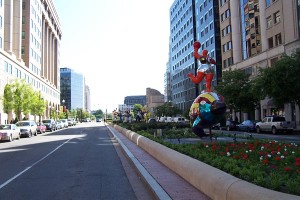
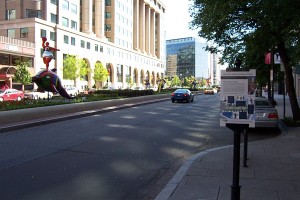
Despite their rotund nature, our local Post critic thinks they lack “weight”. Agreed. To a point. His take on it is that such engaging and fun works lack the potency of the subject matter on the canvases and sculptures within the area’s museums; that there is a dichotomy between our expectations of exterior and interior sculptures. As noted, some of de Saint Phalle’s earlier work has been more exuberantly confrontational and provocative, which these certainly aren’t. No one is being asked to engage with their subconscious thoughts on sexuality, femininity, or aggression – or how these ideas trespass on each other.
I agree that the most interesting of the four is “Serpent Tree” – there are plenty of myths and metaphors regarding trees and snakes to keep the mind occupied. And the execution in such colors, textures, and finishes keeps the eye equally occupied. Except for “Basketball Player”, which should only be permanently installed at the MJ Hall of Fame, I disagree with the assessment that the others will simply provoke a glimpse and a smile because of a lack of fizz beneath the surface – like fading effervescence that goes flat with time. Well, maybe I agree, but maybe that’s all that can be asked. This is because of, and not despite, the location.
These are “plop art” in the sense that they are not connected to place – the glam is befitting NY or Milan, the hippy sentimentality is befitting San Francisco – neither “fit” DC. But they are temporary installations here and they do fit the space if not the place. They are large, eye-catching, colorful, and “pretty”. This contrasts with the asphalt and stone and concrete around them. They are set in a median between several lanes of traffic – they have to compete with a lot of noise and space. They compete relatively well; I did see someone actually cross the road to get close and take a video of one piece.
This leaves me wondering whether a more “thoughtful” piece could work in such a space. I doubt it. Large, brash eye-candy is okay in some places. Something that does both would be wonderful, but in such a space would be exceedingly difficult – my vote would be for four trees – real or otherwise … “I think that I shall never see, a [sculpture] as lovely as a tree”….
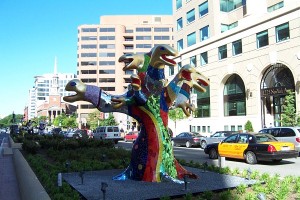
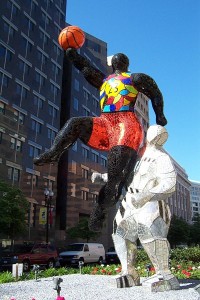
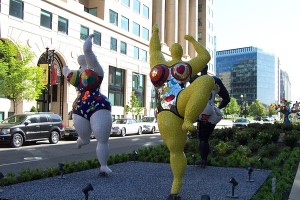
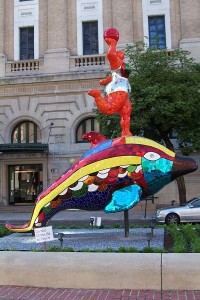

Grenier
For once I’ll be agreeable. There are times a City is happy just to get whatever colorful distraction is available. We’d accept any one of those sculptures on New Hampshire Avenue in Takoma Park in a heart beat. But the silver tree from the sculpture garden … now that is truly awesome. (And yet, as Jane Jacobs says somewhere in Life and Death, ‘beauty can’t be had for the asking.’)
MarkSpizer
great post as usual!
study abroad scholarships
found your site on del.icio.us today and really liked it.. i bookmarked it and will be back to check it out some more later
government grants
Great, I never knew this, thanks.
Paul Grenier
Having second thoughts. My first, gut reaction boiled down to, ‘beggars can’t be choosers.’ In other words, I’ve already been conditioned to a culture that treats public spaces with far less respect than private and enclosed ones. The Post critic was right: this lack of artistic seriousness is a problem.